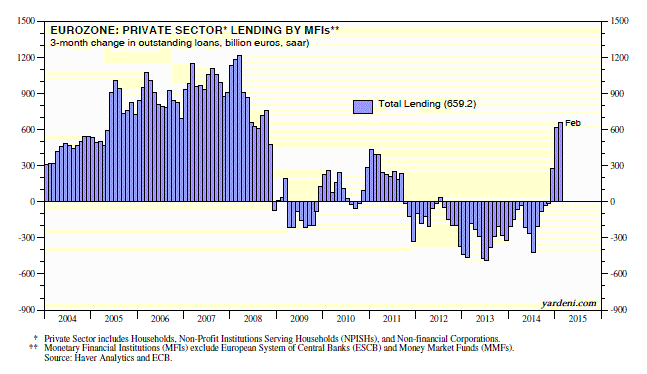
The ECB lowered its deposit rate for banks below zero last year to -0.1% on June 5 and to -0.2% on September 4. The result has been that banks seem to be starting to lend again. This past Friday, we learned that over the past three months through February, Eurozone loans rose €659.2 billion at an annual rate. Lending to households rose €112 billion at an annual rate, while lending to nonfinancial corporations rose €162 billion. Country data are available with more of a lag for lending, which is most likely picking up especially well in Spain and Italy, while continuing to expand in Germany and France.
In addition, there has been a significant upswing in the growth rates of the monetary aggregates in the Eurozone since early last year. M2 is up 4.0% y/y through February, the best pace since August 2013. Furthermore, in local currency terms, the EMU MSCI stock price index is up 17.8% YTD, besting all the other major MSCI indexes as follows: Japan (10.5%), UK (4.2), All-Country World (4.0), Emerging Markets (2.7), and US (0.5).
The Eurozone is benefitting from near-zero interest rates, QE, a weak euro, rising bank lending, soaring stock prices, and lower oil prices. If these six cylinders don’t revive the region’s economy, then nothing will. Of course, the possibility of a Grexit continues to hang over the Eurozone. However, the strong performance of stocks suggests that investors believe it won’t happen or it won’t matter much if it does. I tend to agree.
Today's Morning Briefing: Split Personality. (1) Catalonia and Provence. (2) Additional autonomy more likely than independence. (3) Busy pace in Spain. (4) Draghi more popular than Rajoy. (5) Bank loans starting to expand in Eurozone. (6) Monetary growth rising too. (7) Lots to fuel better growth in Eurozone. (8) Ups and downs for US economy. (9) Employment indicators are upbeat, while production-related ones are mixed. (10) Tale of four cities in Spain and in US. (11) Fed’s talking heads sending mixed message.

